Digital Disruption: Examples of Innovative Disruptors
VerifiedAdded on 2023/06/12
|10
|3261
|353
AI Summary
This report highlights upon various examples of digital disruptions that have been introduced recently. It discusses the impact of digital disruptions on industries and economies across the globe. The report covers examples of Amazon Kindle, Fitness Bands, Uber, Airbnb and more.
Contribute Materials
Your contribution can guide someone’s learning journey. Share your
documents today.
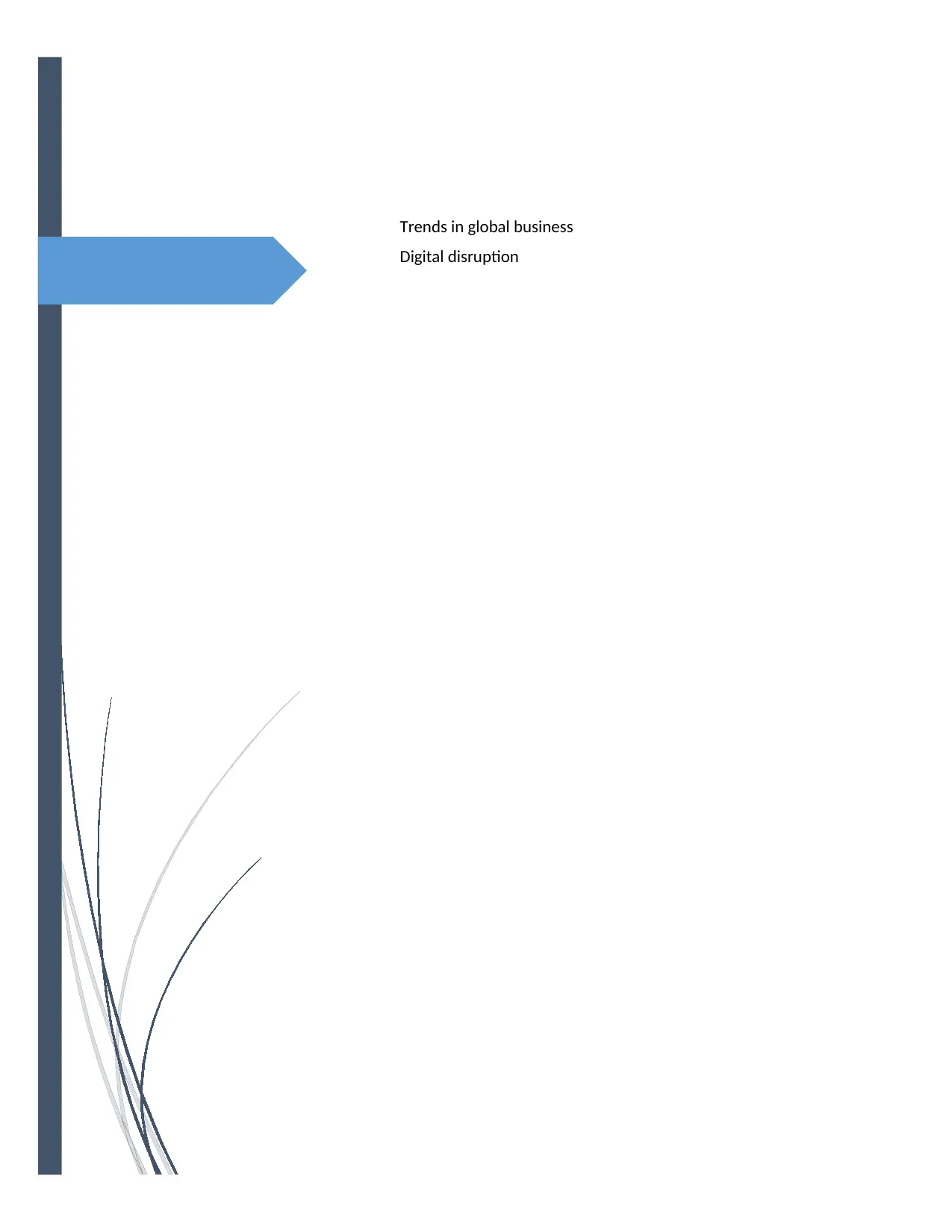
Trends in global business
Digital disruption
Digital disruption
Secure Best Marks with AI Grader
Need help grading? Try our AI Grader for instant feedback on your assignments.
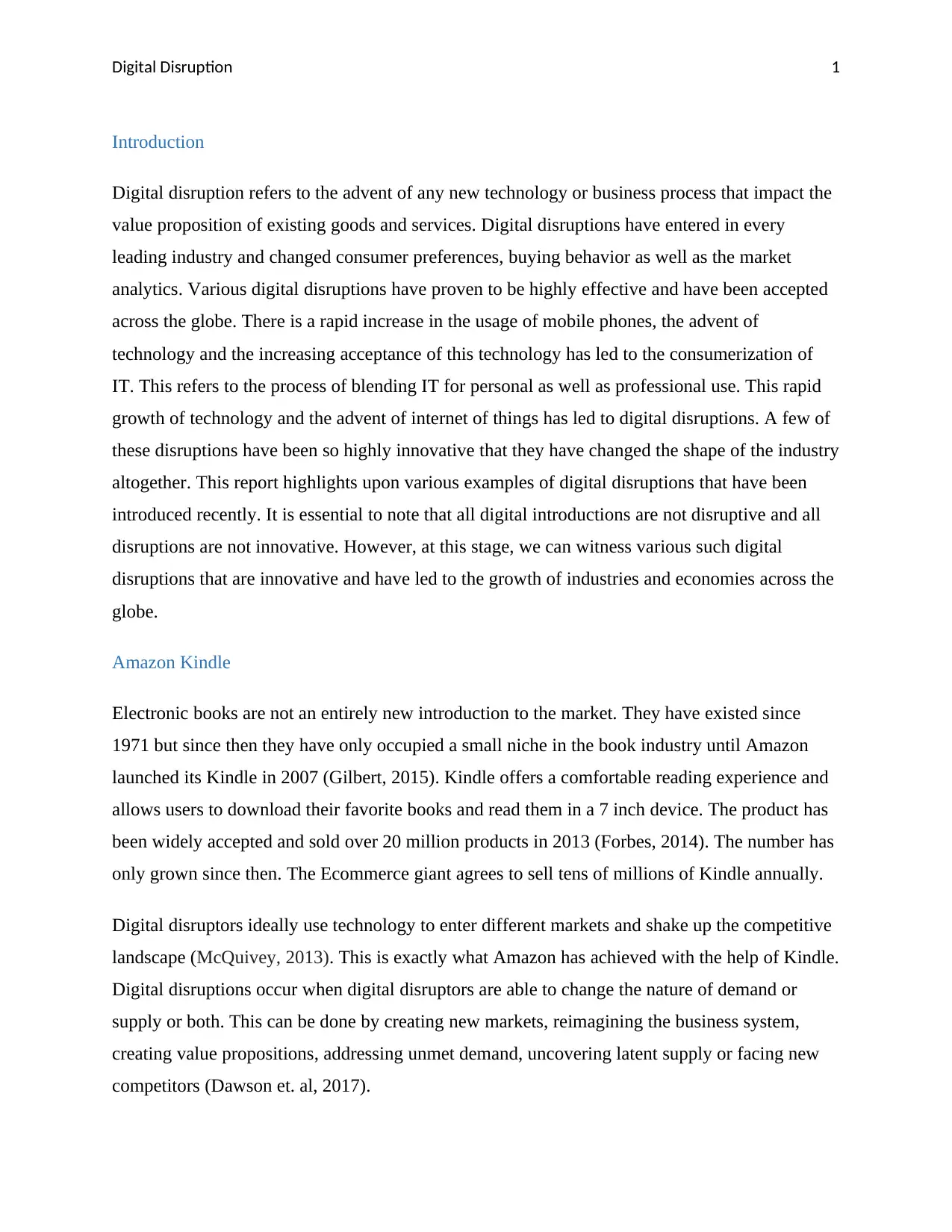
Digital Disruption 1
Introduction
Digital disruption refers to the advent of any new technology or business process that impact the
value proposition of existing goods and services. Digital disruptions have entered in every
leading industry and changed consumer preferences, buying behavior as well as the market
analytics. Various digital disruptions have proven to be highly effective and have been accepted
across the globe. There is a rapid increase in the usage of mobile phones, the advent of
technology and the increasing acceptance of this technology has led to the consumerization of
IT. This refers to the process of blending IT for personal as well as professional use. This rapid
growth of technology and the advent of internet of things has led to digital disruptions. A few of
these disruptions have been so highly innovative that they have changed the shape of the industry
altogether. This report highlights upon various examples of digital disruptions that have been
introduced recently. It is essential to note that all digital introductions are not disruptive and all
disruptions are not innovative. However, at this stage, we can witness various such digital
disruptions that are innovative and have led to the growth of industries and economies across the
globe.
Amazon Kindle
Electronic books are not an entirely new introduction to the market. They have existed since
1971 but since then they have only occupied a small niche in the book industry until Amazon
launched its Kindle in 2007 (Gilbert, 2015). Kindle offers a comfortable reading experience and
allows users to download their favorite books and read them in a 7 inch device. The product has
been widely accepted and sold over 20 million products in 2013 (Forbes, 2014). The number has
only grown since then. The Ecommerce giant agrees to sell tens of millions of Kindle annually.
Digital disruptors ideally use technology to enter different markets and shake up the competitive
landscape (McQuivey, 2013). This is exactly what Amazon has achieved with the help of Kindle.
Digital disruptions occur when digital disruptors are able to change the nature of demand or
supply or both. This can be done by creating new markets, reimagining the business system,
creating value propositions, addressing unmet demand, uncovering latent supply or facing new
competitors (Dawson et. al, 2017).
Introduction
Digital disruption refers to the advent of any new technology or business process that impact the
value proposition of existing goods and services. Digital disruptions have entered in every
leading industry and changed consumer preferences, buying behavior as well as the market
analytics. Various digital disruptions have proven to be highly effective and have been accepted
across the globe. There is a rapid increase in the usage of mobile phones, the advent of
technology and the increasing acceptance of this technology has led to the consumerization of
IT. This refers to the process of blending IT for personal as well as professional use. This rapid
growth of technology and the advent of internet of things has led to digital disruptions. A few of
these disruptions have been so highly innovative that they have changed the shape of the industry
altogether. This report highlights upon various examples of digital disruptions that have been
introduced recently. It is essential to note that all digital introductions are not disruptive and all
disruptions are not innovative. However, at this stage, we can witness various such digital
disruptions that are innovative and have led to the growth of industries and economies across the
globe.
Amazon Kindle
Electronic books are not an entirely new introduction to the market. They have existed since
1971 but since then they have only occupied a small niche in the book industry until Amazon
launched its Kindle in 2007 (Gilbert, 2015). Kindle offers a comfortable reading experience and
allows users to download their favorite books and read them in a 7 inch device. The product has
been widely accepted and sold over 20 million products in 2013 (Forbes, 2014). The number has
only grown since then. The Ecommerce giant agrees to sell tens of millions of Kindle annually.
Digital disruptors ideally use technology to enter different markets and shake up the competitive
landscape (McQuivey, 2013). This is exactly what Amazon has achieved with the help of Kindle.
Digital disruptions occur when digital disruptors are able to change the nature of demand or
supply or both. This can be done by creating new markets, reimagining the business system,
creating value propositions, addressing unmet demand, uncovering latent supply or facing new
competitors (Dawson et. al, 2017).
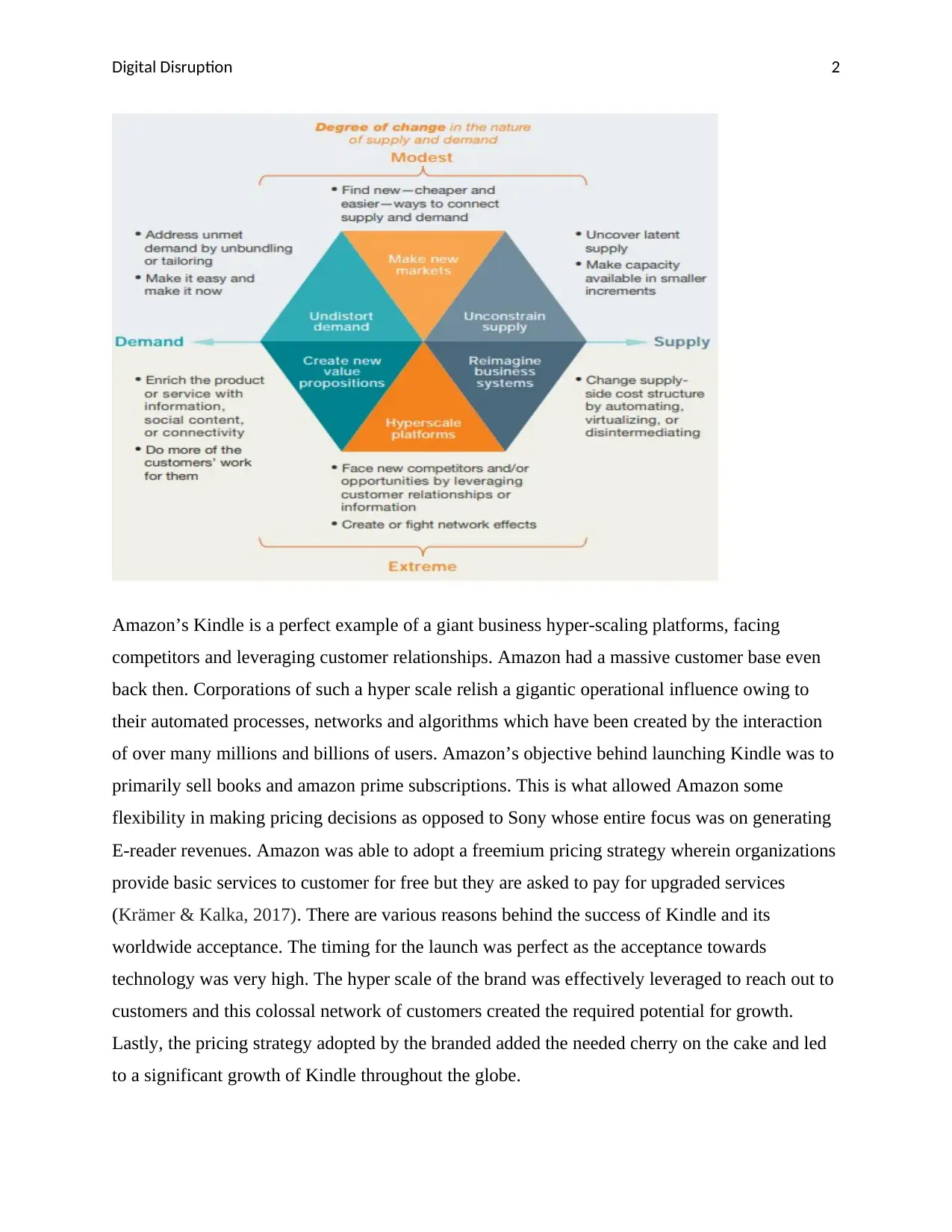
Digital Disruption 2
Amazon’s Kindle is a perfect example of a giant business hyper-scaling platforms, facing
competitors and leveraging customer relationships. Amazon had a massive customer base even
back then. Corporations of such a hyper scale relish a gigantic operational influence owing to
their automated processes, networks and algorithms which have been created by the interaction
of over many millions and billions of users. Amazon’s objective behind launching Kindle was to
primarily sell books and amazon prime subscriptions. This is what allowed Amazon some
flexibility in making pricing decisions as opposed to Sony whose entire focus was on generating
E-reader revenues. Amazon was able to adopt a freemium pricing strategy wherein organizations
provide basic services to customer for free but they are asked to pay for upgraded services
(Krämer & Kalka, 2017). There are various reasons behind the success of Kindle and its
worldwide acceptance. The timing for the launch was perfect as the acceptance towards
technology was very high. The hyper scale of the brand was effectively leveraged to reach out to
customers and this colossal network of customers created the required potential for growth.
Lastly, the pricing strategy adopted by the branded added the needed cherry on the cake and led
to a significant growth of Kindle throughout the globe.
Amazon’s Kindle is a perfect example of a giant business hyper-scaling platforms, facing
competitors and leveraging customer relationships. Amazon had a massive customer base even
back then. Corporations of such a hyper scale relish a gigantic operational influence owing to
their automated processes, networks and algorithms which have been created by the interaction
of over many millions and billions of users. Amazon’s objective behind launching Kindle was to
primarily sell books and amazon prime subscriptions. This is what allowed Amazon some
flexibility in making pricing decisions as opposed to Sony whose entire focus was on generating
E-reader revenues. Amazon was able to adopt a freemium pricing strategy wherein organizations
provide basic services to customer for free but they are asked to pay for upgraded services
(Krämer & Kalka, 2017). There are various reasons behind the success of Kindle and its
worldwide acceptance. The timing for the launch was perfect as the acceptance towards
technology was very high. The hyper scale of the brand was effectively leveraged to reach out to
customers and this colossal network of customers created the required potential for growth.
Lastly, the pricing strategy adopted by the branded added the needed cherry on the cake and led
to a significant growth of Kindle throughout the globe.
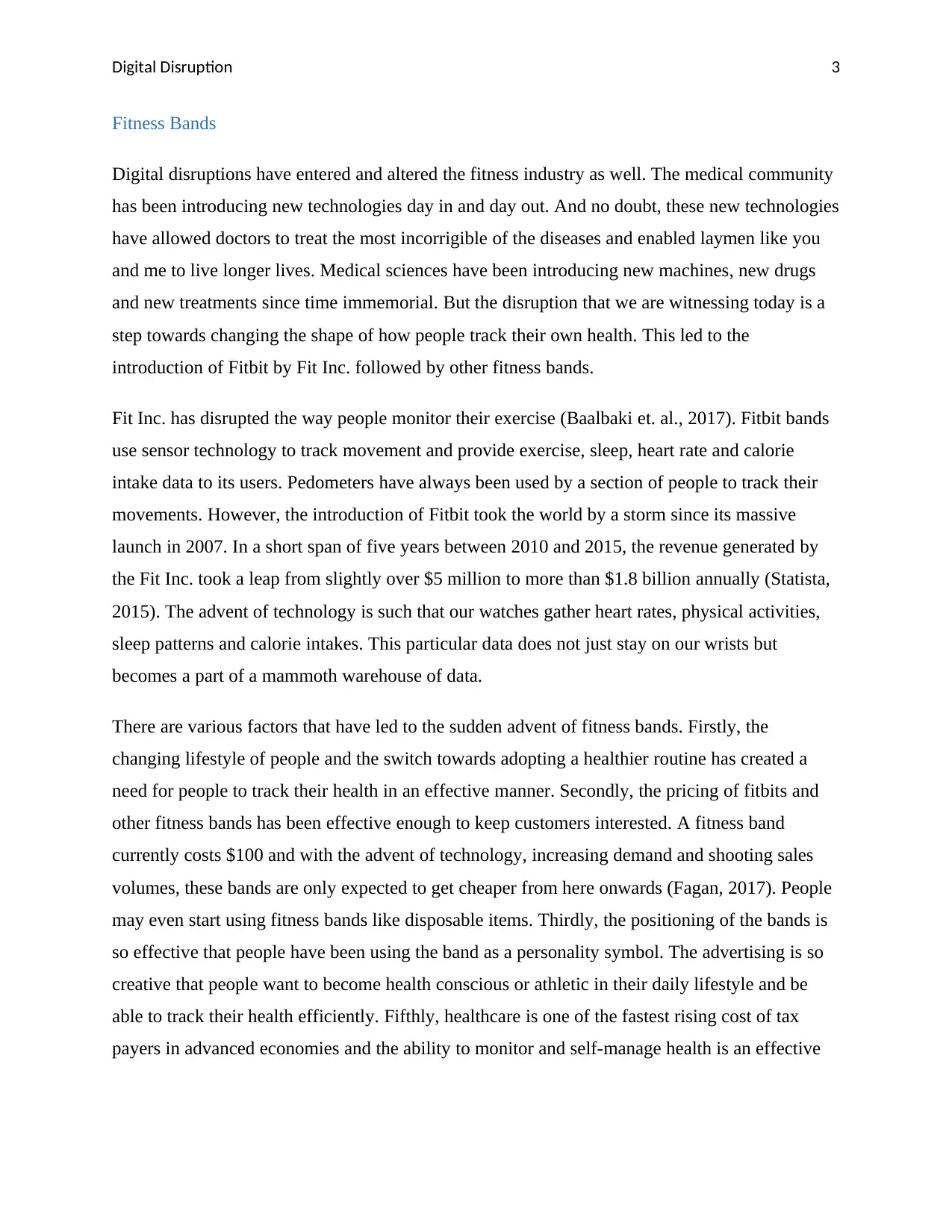
Digital Disruption 3
Fitness Bands
Digital disruptions have entered and altered the fitness industry as well. The medical community
has been introducing new technologies day in and day out. And no doubt, these new technologies
have allowed doctors to treat the most incorrigible of the diseases and enabled laymen like you
and me to live longer lives. Medical sciences have been introducing new machines, new drugs
and new treatments since time immemorial. But the disruption that we are witnessing today is a
step towards changing the shape of how people track their own health. This led to the
introduction of Fitbit by Fit Inc. followed by other fitness bands.
Fit Inc. has disrupted the way people monitor their exercise (Baalbaki et. al., 2017). Fitbit bands
use sensor technology to track movement and provide exercise, sleep, heart rate and calorie
intake data to its users. Pedometers have always been used by a section of people to track their
movements. However, the introduction of Fitbit took the world by a storm since its massive
launch in 2007. In a short span of five years between 2010 and 2015, the revenue generated by
the Fit Inc. took a leap from slightly over $5 million to more than $1.8 billion annually (Statista,
2015). The advent of technology is such that our watches gather heart rates, physical activities,
sleep patterns and calorie intakes. This particular data does not just stay on our wrists but
becomes a part of a mammoth warehouse of data.
There are various factors that have led to the sudden advent of fitness bands. Firstly, the
changing lifestyle of people and the switch towards adopting a healthier routine has created a
need for people to track their health in an effective manner. Secondly, the pricing of fitbits and
other fitness bands has been effective enough to keep customers interested. A fitness band
currently costs $100 and with the advent of technology, increasing demand and shooting sales
volumes, these bands are only expected to get cheaper from here onwards (Fagan, 2017). People
may even start using fitness bands like disposable items. Thirdly, the positioning of the bands is
so effective that people have been using the band as a personality symbol. The advertising is so
creative that people want to become health conscious or athletic in their daily lifestyle and be
able to track their health efficiently. Fifthly, healthcare is one of the fastest rising cost of tax
payers in advanced economies and the ability to monitor and self-manage health is an effective
Fitness Bands
Digital disruptions have entered and altered the fitness industry as well. The medical community
has been introducing new technologies day in and day out. And no doubt, these new technologies
have allowed doctors to treat the most incorrigible of the diseases and enabled laymen like you
and me to live longer lives. Medical sciences have been introducing new machines, new drugs
and new treatments since time immemorial. But the disruption that we are witnessing today is a
step towards changing the shape of how people track their own health. This led to the
introduction of Fitbit by Fit Inc. followed by other fitness bands.
Fit Inc. has disrupted the way people monitor their exercise (Baalbaki et. al., 2017). Fitbit bands
use sensor technology to track movement and provide exercise, sleep, heart rate and calorie
intake data to its users. Pedometers have always been used by a section of people to track their
movements. However, the introduction of Fitbit took the world by a storm since its massive
launch in 2007. In a short span of five years between 2010 and 2015, the revenue generated by
the Fit Inc. took a leap from slightly over $5 million to more than $1.8 billion annually (Statista,
2015). The advent of technology is such that our watches gather heart rates, physical activities,
sleep patterns and calorie intakes. This particular data does not just stay on our wrists but
becomes a part of a mammoth warehouse of data.
There are various factors that have led to the sudden advent of fitness bands. Firstly, the
changing lifestyle of people and the switch towards adopting a healthier routine has created a
need for people to track their health in an effective manner. Secondly, the pricing of fitbits and
other fitness bands has been effective enough to keep customers interested. A fitness band
currently costs $100 and with the advent of technology, increasing demand and shooting sales
volumes, these bands are only expected to get cheaper from here onwards (Fagan, 2017). People
may even start using fitness bands like disposable items. Thirdly, the positioning of the bands is
so effective that people have been using the band as a personality symbol. The advertising is so
creative that people want to become health conscious or athletic in their daily lifestyle and be
able to track their health efficiently. Fifthly, healthcare is one of the fastest rising cost of tax
payers in advanced economies and the ability to monitor and self-manage health is an effective
Paraphrase This Document
Need a fresh take? Get an instant paraphrase of this document with our AI Paraphraser
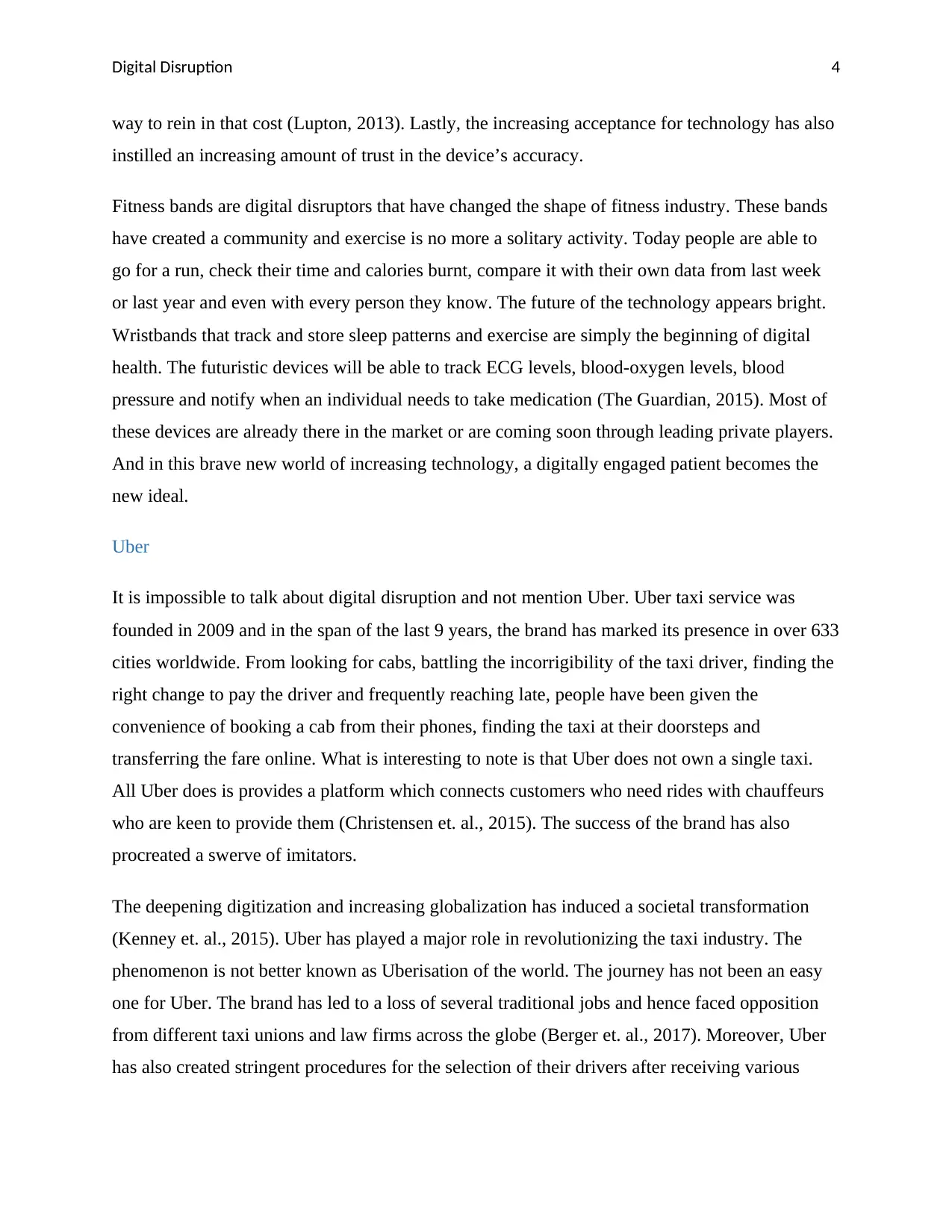
Digital Disruption 4
way to rein in that cost (Lupton, 2013). Lastly, the increasing acceptance for technology has also
instilled an increasing amount of trust in the device’s accuracy.
Fitness bands are digital disruptors that have changed the shape of fitness industry. These bands
have created a community and exercise is no more a solitary activity. Today people are able to
go for a run, check their time and calories burnt, compare it with their own data from last week
or last year and even with every person they know. The future of the technology appears bright.
Wristbands that track and store sleep patterns and exercise are simply the beginning of digital
health. The futuristic devices will be able to track ECG levels, blood-oxygen levels, blood
pressure and notify when an individual needs to take medication (The Guardian, 2015). Most of
these devices are already there in the market or are coming soon through leading private players.
And in this brave new world of increasing technology, a digitally engaged patient becomes the
new ideal.
Uber
It is impossible to talk about digital disruption and not mention Uber. Uber taxi service was
founded in 2009 and in the span of the last 9 years, the brand has marked its presence in over 633
cities worldwide. From looking for cabs, battling the incorrigibility of the taxi driver, finding the
right change to pay the driver and frequently reaching late, people have been given the
convenience of booking a cab from their phones, finding the taxi at their doorsteps and
transferring the fare online. What is interesting to note is that Uber does not own a single taxi.
All Uber does is provides a platform which connects customers who need rides with chauffeurs
who are keen to provide them (Christensen et. al., 2015). The success of the brand has also
procreated a swerve of imitators.
The deepening digitization and increasing globalization has induced a societal transformation
(Kenney et. al., 2015). Uber has played a major role in revolutionizing the taxi industry. The
phenomenon is not better known as Uberisation of the world. The journey has not been an easy
one for Uber. The brand has led to a loss of several traditional jobs and hence faced opposition
from different taxi unions and law firms across the globe (Berger et. al., 2017). Moreover, Uber
has also created stringent procedures for the selection of their drivers after receiving various
way to rein in that cost (Lupton, 2013). Lastly, the increasing acceptance for technology has also
instilled an increasing amount of trust in the device’s accuracy.
Fitness bands are digital disruptors that have changed the shape of fitness industry. These bands
have created a community and exercise is no more a solitary activity. Today people are able to
go for a run, check their time and calories burnt, compare it with their own data from last week
or last year and even with every person they know. The future of the technology appears bright.
Wristbands that track and store sleep patterns and exercise are simply the beginning of digital
health. The futuristic devices will be able to track ECG levels, blood-oxygen levels, blood
pressure and notify when an individual needs to take medication (The Guardian, 2015). Most of
these devices are already there in the market or are coming soon through leading private players.
And in this brave new world of increasing technology, a digitally engaged patient becomes the
new ideal.
Uber
It is impossible to talk about digital disruption and not mention Uber. Uber taxi service was
founded in 2009 and in the span of the last 9 years, the brand has marked its presence in over 633
cities worldwide. From looking for cabs, battling the incorrigibility of the taxi driver, finding the
right change to pay the driver and frequently reaching late, people have been given the
convenience of booking a cab from their phones, finding the taxi at their doorsteps and
transferring the fare online. What is interesting to note is that Uber does not own a single taxi.
All Uber does is provides a platform which connects customers who need rides with chauffeurs
who are keen to provide them (Christensen et. al., 2015). The success of the brand has also
procreated a swerve of imitators.
The deepening digitization and increasing globalization has induced a societal transformation
(Kenney et. al., 2015). Uber has played a major role in revolutionizing the taxi industry. The
phenomenon is not better known as Uberisation of the world. The journey has not been an easy
one for Uber. The brand has led to a loss of several traditional jobs and hence faced opposition
from different taxi unions and law firms across the globe (Berger et. al., 2017). Moreover, Uber
has also created stringent procedures for the selection of their drivers after receiving various
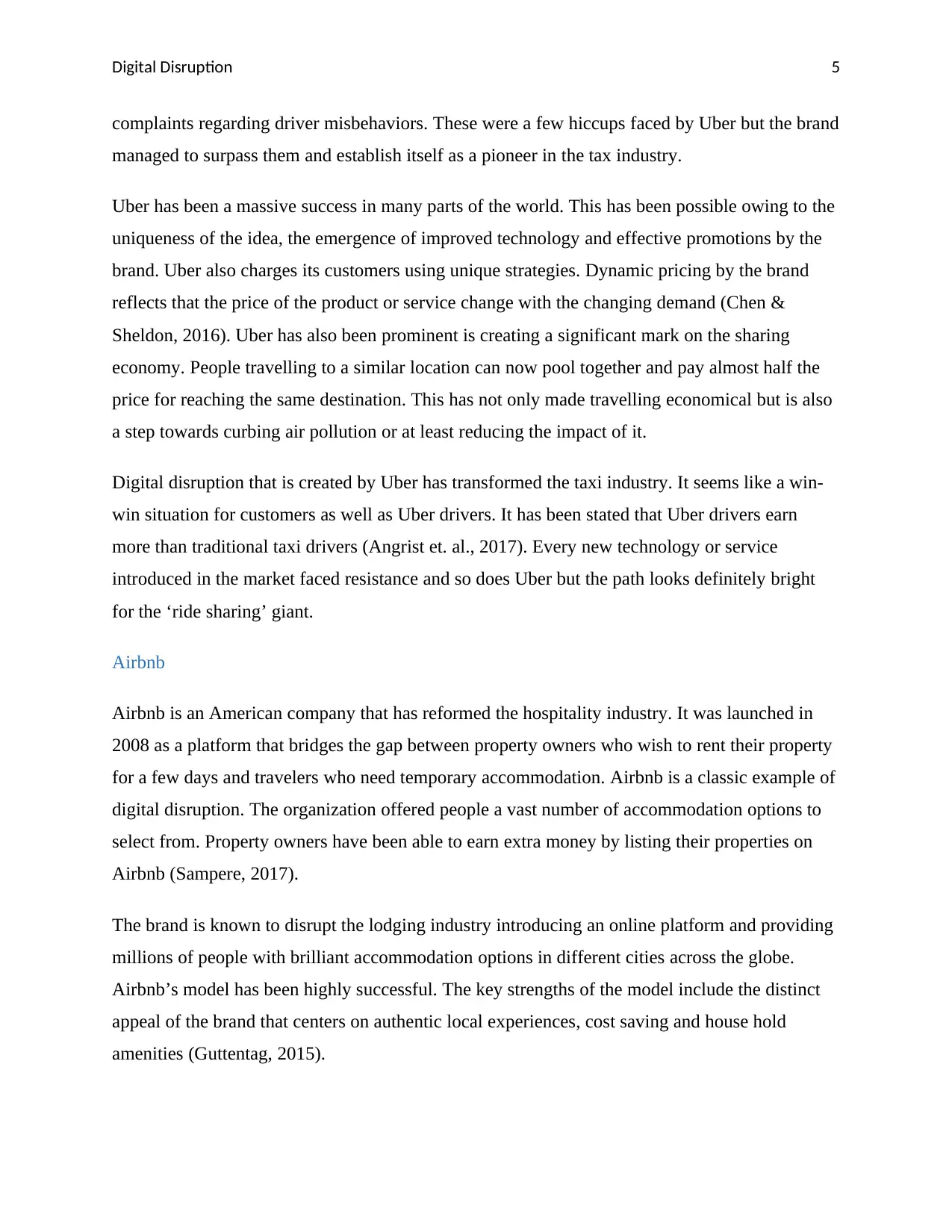
Digital Disruption 5
complaints regarding driver misbehaviors. These were a few hiccups faced by Uber but the brand
managed to surpass them and establish itself as a pioneer in the tax industry.
Uber has been a massive success in many parts of the world. This has been possible owing to the
uniqueness of the idea, the emergence of improved technology and effective promotions by the
brand. Uber also charges its customers using unique strategies. Dynamic pricing by the brand
reflects that the price of the product or service change with the changing demand (Chen &
Sheldon, 2016). Uber has also been prominent is creating a significant mark on the sharing
economy. People travelling to a similar location can now pool together and pay almost half the
price for reaching the same destination. This has not only made travelling economical but is also
a step towards curbing air pollution or at least reducing the impact of it.
Digital disruption that is created by Uber has transformed the taxi industry. It seems like a win-
win situation for customers as well as Uber drivers. It has been stated that Uber drivers earn
more than traditional taxi drivers (Angrist et. al., 2017). Every new technology or service
introduced in the market faced resistance and so does Uber but the path looks definitely bright
for the ‘ride sharing’ giant.
Airbnb
Airbnb is an American company that has reformed the hospitality industry. It was launched in
2008 as a platform that bridges the gap between property owners who wish to rent their property
for a few days and travelers who need temporary accommodation. Airbnb is a classic example of
digital disruption. The organization offered people a vast number of accommodation options to
select from. Property owners have been able to earn extra money by listing their properties on
Airbnb (Sampere, 2017).
The brand is known to disrupt the lodging industry introducing an online platform and providing
millions of people with brilliant accommodation options in different cities across the globe.
Airbnb’s model has been highly successful. The key strengths of the model include the distinct
appeal of the brand that centers on authentic local experiences, cost saving and house hold
amenities (Guttentag, 2015).
complaints regarding driver misbehaviors. These were a few hiccups faced by Uber but the brand
managed to surpass them and establish itself as a pioneer in the tax industry.
Uber has been a massive success in many parts of the world. This has been possible owing to the
uniqueness of the idea, the emergence of improved technology and effective promotions by the
brand. Uber also charges its customers using unique strategies. Dynamic pricing by the brand
reflects that the price of the product or service change with the changing demand (Chen &
Sheldon, 2016). Uber has also been prominent is creating a significant mark on the sharing
economy. People travelling to a similar location can now pool together and pay almost half the
price for reaching the same destination. This has not only made travelling economical but is also
a step towards curbing air pollution or at least reducing the impact of it.
Digital disruption that is created by Uber has transformed the taxi industry. It seems like a win-
win situation for customers as well as Uber drivers. It has been stated that Uber drivers earn
more than traditional taxi drivers (Angrist et. al., 2017). Every new technology or service
introduced in the market faced resistance and so does Uber but the path looks definitely bright
for the ‘ride sharing’ giant.
Airbnb
Airbnb is an American company that has reformed the hospitality industry. It was launched in
2008 as a platform that bridges the gap between property owners who wish to rent their property
for a few days and travelers who need temporary accommodation. Airbnb is a classic example of
digital disruption. The organization offered people a vast number of accommodation options to
select from. Property owners have been able to earn extra money by listing their properties on
Airbnb (Sampere, 2017).
The brand is known to disrupt the lodging industry introducing an online platform and providing
millions of people with brilliant accommodation options in different cities across the globe.
Airbnb’s model has been highly successful. The key strengths of the model include the distinct
appeal of the brand that centers on authentic local experiences, cost saving and house hold
amenities (Guttentag, 2015).
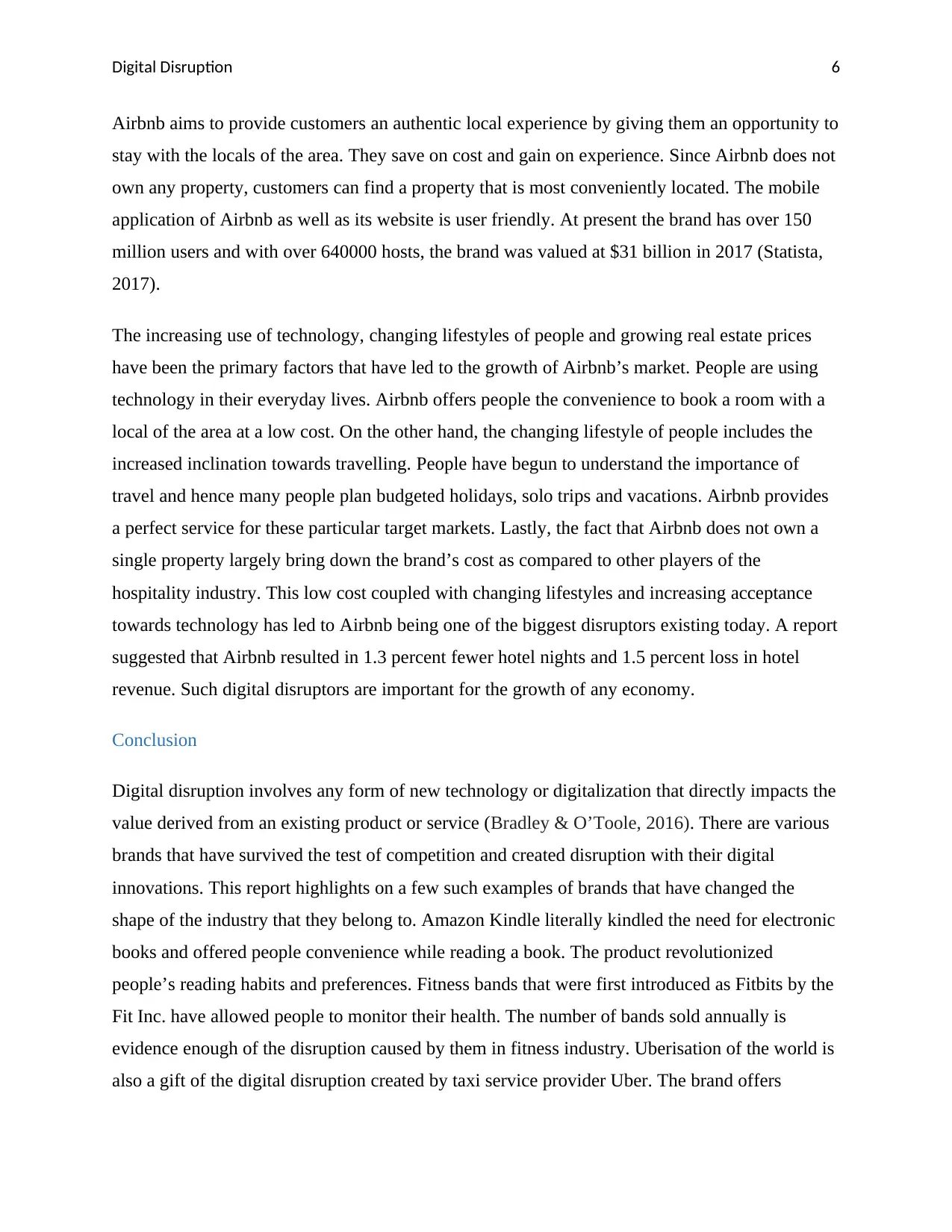
Digital Disruption 6
Airbnb aims to provide customers an authentic local experience by giving them an opportunity to
stay with the locals of the area. They save on cost and gain on experience. Since Airbnb does not
own any property, customers can find a property that is most conveniently located. The mobile
application of Airbnb as well as its website is user friendly. At present the brand has over 150
million users and with over 640000 hosts, the brand was valued at $31 billion in 2017 (Statista,
2017).
The increasing use of technology, changing lifestyles of people and growing real estate prices
have been the primary factors that have led to the growth of Airbnb’s market. People are using
technology in their everyday lives. Airbnb offers people the convenience to book a room with a
local of the area at a low cost. On the other hand, the changing lifestyle of people includes the
increased inclination towards travelling. People have begun to understand the importance of
travel and hence many people plan budgeted holidays, solo trips and vacations. Airbnb provides
a perfect service for these particular target markets. Lastly, the fact that Airbnb does not own a
single property largely bring down the brand’s cost as compared to other players of the
hospitality industry. This low cost coupled with changing lifestyles and increasing acceptance
towards technology has led to Airbnb being one of the biggest disruptors existing today. A report
suggested that Airbnb resulted in 1.3 percent fewer hotel nights and 1.5 percent loss in hotel
revenue. Such digital disruptors are important for the growth of any economy.
Conclusion
Digital disruption involves any form of new technology or digitalization that directly impacts the
value derived from an existing product or service (Bradley & O’Toole, 2016). There are various
brands that have survived the test of competition and created disruption with their digital
innovations. This report highlights on a few such examples of brands that have changed the
shape of the industry that they belong to. Amazon Kindle literally kindled the need for electronic
books and offered people convenience while reading a book. The product revolutionized
people’s reading habits and preferences. Fitness bands that were first introduced as Fitbits by the
Fit Inc. have allowed people to monitor their health. The number of bands sold annually is
evidence enough of the disruption caused by them in fitness industry. Uberisation of the world is
also a gift of the digital disruption created by taxi service provider Uber. The brand offers
Airbnb aims to provide customers an authentic local experience by giving them an opportunity to
stay with the locals of the area. They save on cost and gain on experience. Since Airbnb does not
own any property, customers can find a property that is most conveniently located. The mobile
application of Airbnb as well as its website is user friendly. At present the brand has over 150
million users and with over 640000 hosts, the brand was valued at $31 billion in 2017 (Statista,
2017).
The increasing use of technology, changing lifestyles of people and growing real estate prices
have been the primary factors that have led to the growth of Airbnb’s market. People are using
technology in their everyday lives. Airbnb offers people the convenience to book a room with a
local of the area at a low cost. On the other hand, the changing lifestyle of people includes the
increased inclination towards travelling. People have begun to understand the importance of
travel and hence many people plan budgeted holidays, solo trips and vacations. Airbnb provides
a perfect service for these particular target markets. Lastly, the fact that Airbnb does not own a
single property largely bring down the brand’s cost as compared to other players of the
hospitality industry. This low cost coupled with changing lifestyles and increasing acceptance
towards technology has led to Airbnb being one of the biggest disruptors existing today. A report
suggested that Airbnb resulted in 1.3 percent fewer hotel nights and 1.5 percent loss in hotel
revenue. Such digital disruptors are important for the growth of any economy.
Conclusion
Digital disruption involves any form of new technology or digitalization that directly impacts the
value derived from an existing product or service (Bradley & O’Toole, 2016). There are various
brands that have survived the test of competition and created disruption with their digital
innovations. This report highlights on a few such examples of brands that have changed the
shape of the industry that they belong to. Amazon Kindle literally kindled the need for electronic
books and offered people convenience while reading a book. The product revolutionized
people’s reading habits and preferences. Fitness bands that were first introduced as Fitbits by the
Fit Inc. have allowed people to monitor their health. The number of bands sold annually is
evidence enough of the disruption caused by them in fitness industry. Uberisation of the world is
also a gift of the digital disruption created by taxi service provider Uber. The brand offers
Secure Best Marks with AI Grader
Need help grading? Try our AI Grader for instant feedback on your assignments.
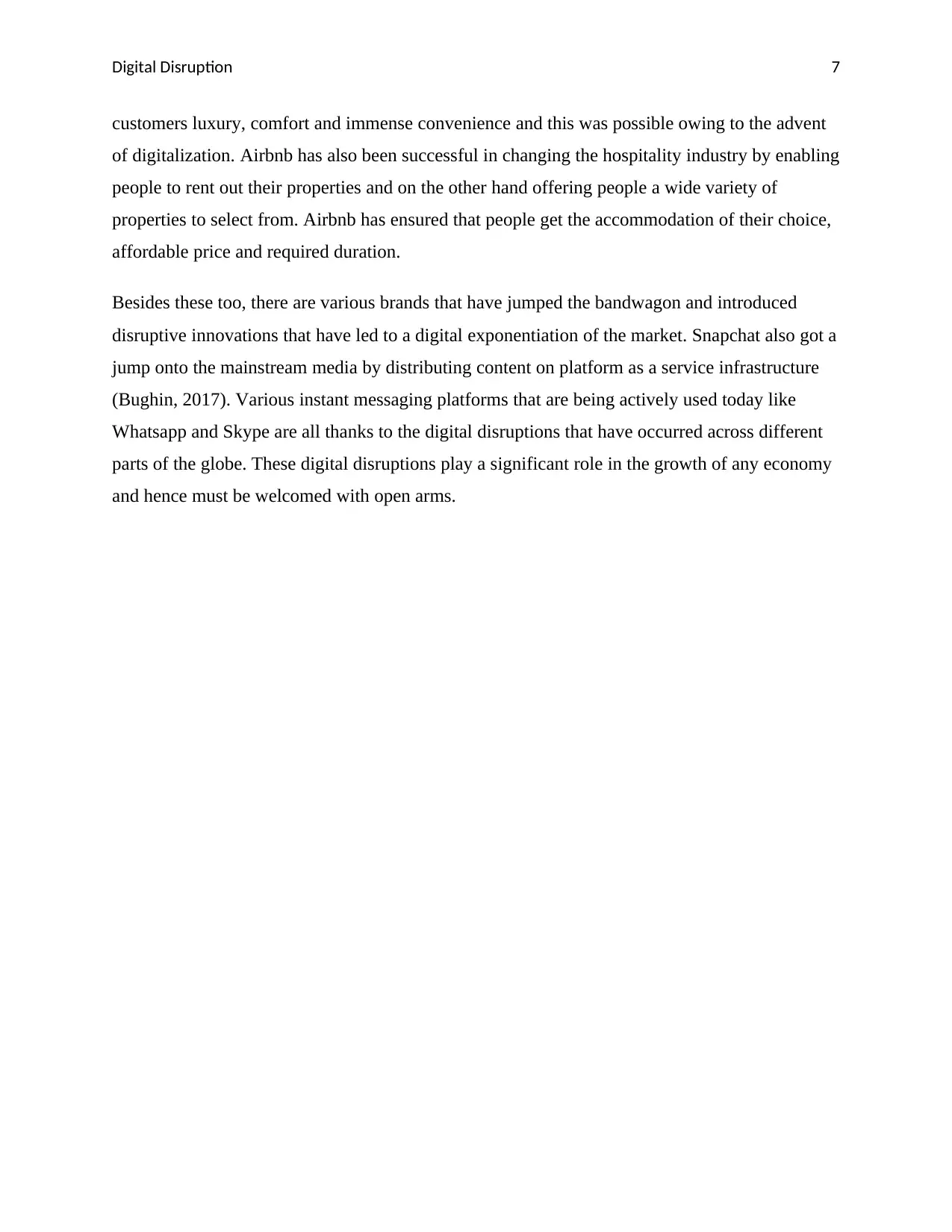
Digital Disruption 7
customers luxury, comfort and immense convenience and this was possible owing to the advent
of digitalization. Airbnb has also been successful in changing the hospitality industry by enabling
people to rent out their properties and on the other hand offering people a wide variety of
properties to select from. Airbnb has ensured that people get the accommodation of their choice,
affordable price and required duration.
Besides these too, there are various brands that have jumped the bandwagon and introduced
disruptive innovations that have led to a digital exponentiation of the market. Snapchat also got a
jump onto the mainstream media by distributing content on platform as a service infrastructure
(Bughin, 2017). Various instant messaging platforms that are being actively used today like
Whatsapp and Skype are all thanks to the digital disruptions that have occurred across different
parts of the globe. These digital disruptions play a significant role in the growth of any economy
and hence must be welcomed with open arms.
customers luxury, comfort and immense convenience and this was possible owing to the advent
of digitalization. Airbnb has also been successful in changing the hospitality industry by enabling
people to rent out their properties and on the other hand offering people a wide variety of
properties to select from. Airbnb has ensured that people get the accommodation of their choice,
affordable price and required duration.
Besides these too, there are various brands that have jumped the bandwagon and introduced
disruptive innovations that have led to a digital exponentiation of the market. Snapchat also got a
jump onto the mainstream media by distributing content on platform as a service infrastructure
(Bughin, 2017). Various instant messaging platforms that are being actively used today like
Whatsapp and Skype are all thanks to the digital disruptions that have occurred across different
parts of the globe. These digital disruptions play a significant role in the growth of any economy
and hence must be welcomed with open arms.
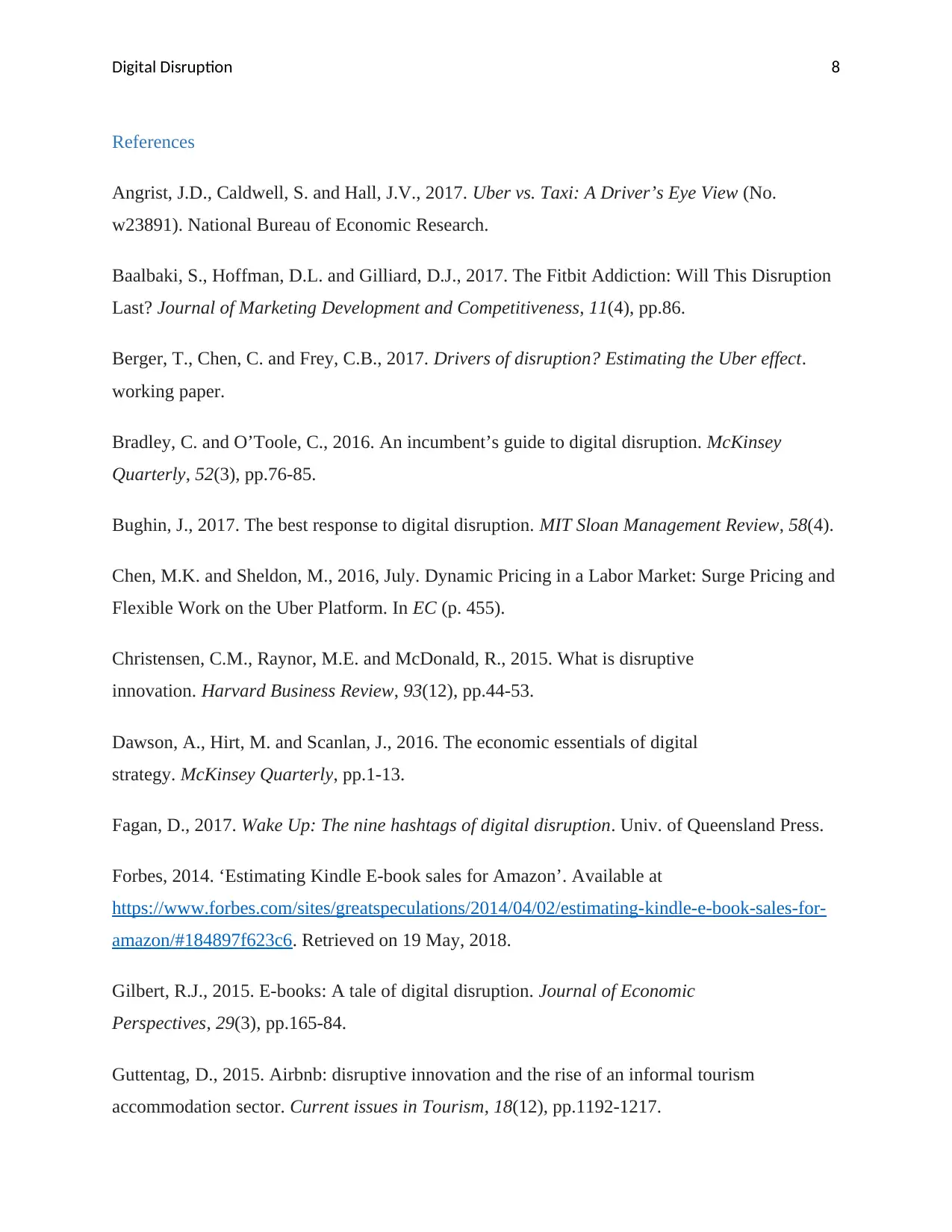
Digital Disruption 8
References
Angrist, J.D., Caldwell, S. and Hall, J.V., 2017. Uber vs. Taxi: A Driver’s Eye View (No.
w23891). National Bureau of Economic Research.
Baalbaki, S., Hoffman, D.L. and Gilliard, D.J., 2017. The Fitbit Addiction: Will This Disruption
Last? Journal of Marketing Development and Competitiveness, 11(4), pp.86.
Berger, T., Chen, C. and Frey, C.B., 2017. Drivers of disruption? Estimating the Uber effect.
working paper.
Bradley, C. and O’Toole, C., 2016. An incumbent’s guide to digital disruption. McKinsey
Quarterly, 52(3), pp.76-85.
Bughin, J., 2017. The best response to digital disruption. MIT Sloan Management Review, 58(4).
Chen, M.K. and Sheldon, M., 2016, July. Dynamic Pricing in a Labor Market: Surge Pricing and
Flexible Work on the Uber Platform. In EC (p. 455).
Christensen, C.M., Raynor, M.E. and McDonald, R., 2015. What is disruptive
innovation. Harvard Business Review, 93(12), pp.44-53.
Dawson, A., Hirt, M. and Scanlan, J., 2016. The economic essentials of digital
strategy. McKinsey Quarterly, pp.1-13.
Fagan, D., 2017. Wake Up: The nine hashtags of digital disruption. Univ. of Queensland Press.
Forbes, 2014. ‘Estimating Kindle E-book sales for Amazon’. Available at
https://www.forbes.com/sites/greatspeculations/2014/04/02/estimating-kindle-e-book-sales-for-
amazon/#184897f623c6. Retrieved on 19 May, 2018.
Gilbert, R.J., 2015. E-books: A tale of digital disruption. Journal of Economic
Perspectives, 29(3), pp.165-84.
Guttentag, D., 2015. Airbnb: disruptive innovation and the rise of an informal tourism
accommodation sector. Current issues in Tourism, 18(12), pp.1192-1217.
References
Angrist, J.D., Caldwell, S. and Hall, J.V., 2017. Uber vs. Taxi: A Driver’s Eye View (No.
w23891). National Bureau of Economic Research.
Baalbaki, S., Hoffman, D.L. and Gilliard, D.J., 2017. The Fitbit Addiction: Will This Disruption
Last? Journal of Marketing Development and Competitiveness, 11(4), pp.86.
Berger, T., Chen, C. and Frey, C.B., 2017. Drivers of disruption? Estimating the Uber effect.
working paper.
Bradley, C. and O’Toole, C., 2016. An incumbent’s guide to digital disruption. McKinsey
Quarterly, 52(3), pp.76-85.
Bughin, J., 2017. The best response to digital disruption. MIT Sloan Management Review, 58(4).
Chen, M.K. and Sheldon, M., 2016, July. Dynamic Pricing in a Labor Market: Surge Pricing and
Flexible Work on the Uber Platform. In EC (p. 455).
Christensen, C.M., Raynor, M.E. and McDonald, R., 2015. What is disruptive
innovation. Harvard Business Review, 93(12), pp.44-53.
Dawson, A., Hirt, M. and Scanlan, J., 2016. The economic essentials of digital
strategy. McKinsey Quarterly, pp.1-13.
Fagan, D., 2017. Wake Up: The nine hashtags of digital disruption. Univ. of Queensland Press.
Forbes, 2014. ‘Estimating Kindle E-book sales for Amazon’. Available at
https://www.forbes.com/sites/greatspeculations/2014/04/02/estimating-kindle-e-book-sales-for-
amazon/#184897f623c6. Retrieved on 19 May, 2018.
Gilbert, R.J., 2015. E-books: A tale of digital disruption. Journal of Economic
Perspectives, 29(3), pp.165-84.
Guttentag, D., 2015. Airbnb: disruptive innovation and the rise of an informal tourism
accommodation sector. Current issues in Tourism, 18(12), pp.1192-1217.
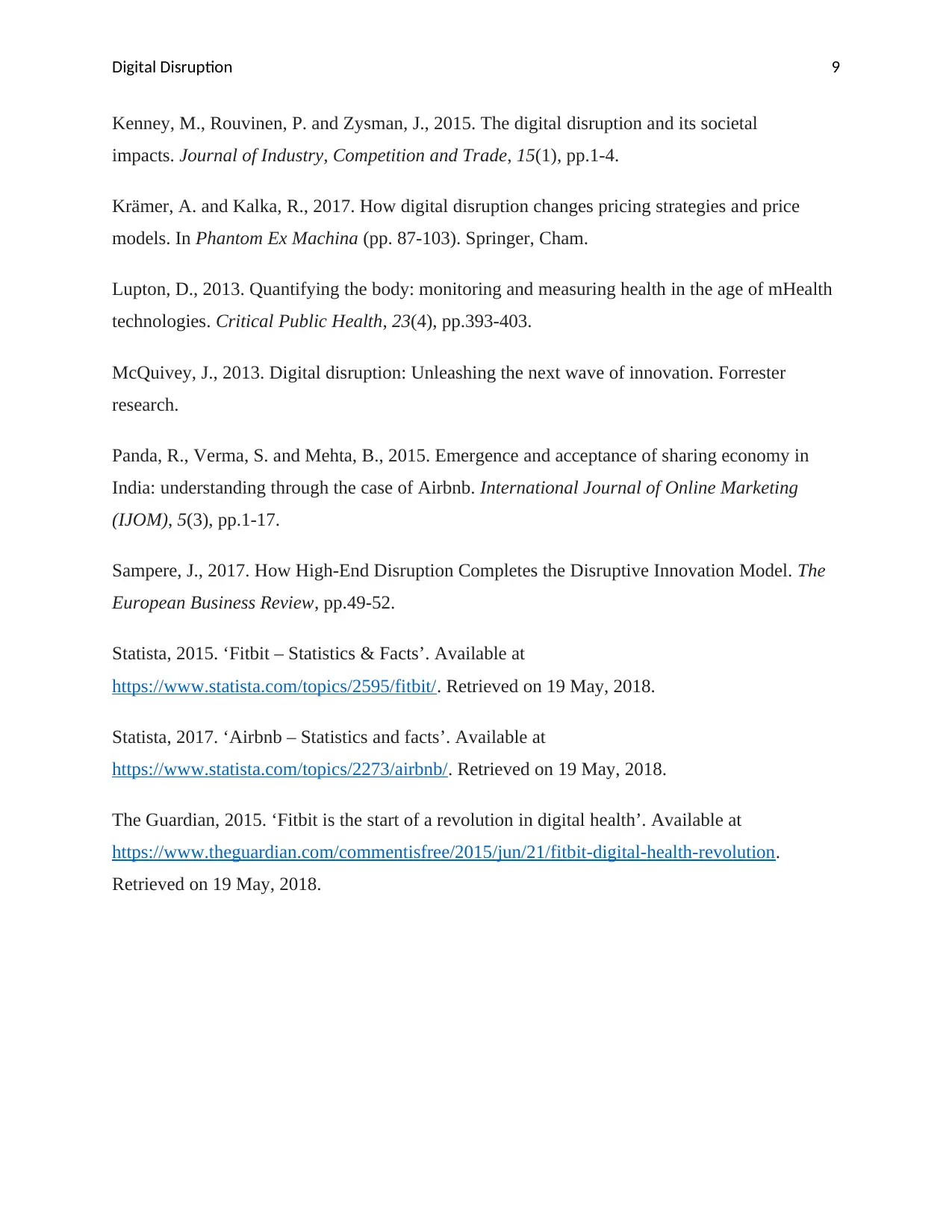
Digital Disruption 9
Kenney, M., Rouvinen, P. and Zysman, J., 2015. The digital disruption and its societal
impacts. Journal of Industry, Competition and Trade, 15(1), pp.1-4.
Krämer, A. and Kalka, R., 2017. How digital disruption changes pricing strategies and price
models. In Phantom Ex Machina (pp. 87-103). Springer, Cham.
Lupton, D., 2013. Quantifying the body: monitoring and measuring health in the age of mHealth
technologies. Critical Public Health, 23(4), pp.393-403.
McQuivey, J., 2013. Digital disruption: Unleashing the next wave of innovation. Forrester
research.
Panda, R., Verma, S. and Mehta, B., 2015. Emergence and acceptance of sharing economy in
India: understanding through the case of Airbnb. International Journal of Online Marketing
(IJOM), 5(3), pp.1-17.
Sampere, J., 2017. How High-End Disruption Completes the Disruptive Innovation Model. The
European Business Review, pp.49-52.
Statista, 2015. ‘Fitbit – Statistics & Facts’. Available at
https://www.statista.com/topics/2595/fitbit/. Retrieved on 19 May, 2018.
Statista, 2017. ‘Airbnb – Statistics and facts’. Available at
https://www.statista.com/topics/2273/airbnb/. Retrieved on 19 May, 2018.
The Guardian, 2015. ‘Fitbit is the start of a revolution in digital health’. Available at
https://www.theguardian.com/commentisfree/2015/jun/21/fitbit-digital-health-revolution.
Retrieved on 19 May, 2018.
Kenney, M., Rouvinen, P. and Zysman, J., 2015. The digital disruption and its societal
impacts. Journal of Industry, Competition and Trade, 15(1), pp.1-4.
Krämer, A. and Kalka, R., 2017. How digital disruption changes pricing strategies and price
models. In Phantom Ex Machina (pp. 87-103). Springer, Cham.
Lupton, D., 2013. Quantifying the body: monitoring and measuring health in the age of mHealth
technologies. Critical Public Health, 23(4), pp.393-403.
McQuivey, J., 2013. Digital disruption: Unleashing the next wave of innovation. Forrester
research.
Panda, R., Verma, S. and Mehta, B., 2015. Emergence and acceptance of sharing economy in
India: understanding through the case of Airbnb. International Journal of Online Marketing
(IJOM), 5(3), pp.1-17.
Sampere, J., 2017. How High-End Disruption Completes the Disruptive Innovation Model. The
European Business Review, pp.49-52.
Statista, 2015. ‘Fitbit – Statistics & Facts’. Available at
https://www.statista.com/topics/2595/fitbit/. Retrieved on 19 May, 2018.
Statista, 2017. ‘Airbnb – Statistics and facts’. Available at
https://www.statista.com/topics/2273/airbnb/. Retrieved on 19 May, 2018.
The Guardian, 2015. ‘Fitbit is the start of a revolution in digital health’. Available at
https://www.theguardian.com/commentisfree/2015/jun/21/fitbit-digital-health-revolution.
Retrieved on 19 May, 2018.
1 out of 10
![[object Object]](/_next/static/media/star-bottom.7253800d.svg)





